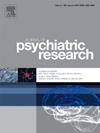Is more better? Comparing 600, 1200 and 1800 pulses/session (p/s) of intermittent theta-burst stimulation (iTBS) for the treatment of depression
IF 3.7
2区 医学
Q1 PSYCHIATRY
引用次数: 0
Abstract
Introduction
Repetitive Transcranial magnetic stimulation (rTMS) is a non-invasive therapy for treatment-resistant disorders. Intermittent theta-burst stimulation (iTBS) has emerged as a favorite treatment protocol for the treatment of therapy resistant depression, with the tendency to administer an increasing number of pulses/session (p/s).
Methods
We retrospectively analyzed the records of 215 in- and out-patients, suffering from unipolar or bipolar depressive disorder in a German tertiary care hospital between January 2021 and September 2024. All patients received left prefrontal iTBS with either 600 (n = 68), 1200 (n = 67) or 1800 (n = 80) p/s over the course of 15–20 days. Depressive symptoms were assessed with the 21-item Hamilton Depression Rating Scale (HAMD-21) and the Major Depression Inventory (MDI) before and at the end of the respective treatment. Side effects were quantified by the number of patients reporting a side effect in at least one of the rTMS sessions.
Results
In all groups, the HAMD-21 and MDI scores improved significantly. There was no significant difference between the three groups (HAMD-21: p = .198, MDI: p = .281). Further, this result equally applies to men and women (all p′s > .145). No serious side effects occurred. Patients who were treated with 600 p/s reported most side effects.
Conclusion
Our retrospective analysis suggests that an increase of p/s from 600 to 1200 or 1800 does not result in more pronounced antidepressant effects.
越多越好吗?比较600、1200和1800脉冲/秒间歇脉冲刺激(iTBS)治疗抑郁症的效果
重复经颅磁刺激(rTMS)是治疗难治性疾病的一种非侵入性治疗方法。间歇性脉冲刺激(iTBS)已成为治疗难治性抑郁症的首选治疗方案,其脉冲/次(p/s)的次数越来越多。方法回顾性分析2021年1月至2024年9月在德国一家三级医院就诊的215例单极或双相抑郁症患者的住院和门诊记录。所有患者在15-20天内接受左前额叶iTBS,分别为600 (n = 68)、1200 (n = 67)或1800 (n = 80) p/s。分别在治疗前和治疗结束时用21项汉密尔顿抑郁评定量表(HAMD-21)和重度抑郁量表(MDI)评估抑郁症状。通过在至少一次rTMS治疗中报告出现副作用的患者数量来量化副作用。结果各组患者HAMD-21、MDI评分均有显著提高。三组间差异无统计学意义(HAMD-21: p = 0.198, MDI: p = 0.281)。此外,这一结果同样适用于男性和女性(所有的p >;.145)。没有发生严重的副作用。以600p /s治疗的患者报告的副作用最多。结论我们的回顾性分析表明,p/s从600增加到1200或1800并不会导致更明显的抗抑郁作用。
本文章由计算机程序翻译,如有差异,请以英文原文为准。
求助全文
约1分钟内获得全文
求助全文
来源期刊

Journal of psychiatric research
医学-精神病学
CiteScore
7.30
自引率
2.10%
发文量
622
审稿时长
130 days
期刊介绍:
Founded in 1961 to report on the latest work in psychiatry and cognate disciplines, the Journal of Psychiatric Research is dedicated to innovative and timely studies of four important areas of research:
(1) clinical studies of all disciplines relating to psychiatric illness, as well as normal human behaviour, including biochemical, physiological, genetic, environmental, social, psychological and epidemiological factors;
(2) basic studies pertaining to psychiatry in such fields as neuropsychopharmacology, neuroendocrinology, electrophysiology, genetics, experimental psychology and epidemiology;
(3) the growing application of clinical laboratory techniques in psychiatry, including imagery and spectroscopy of the brain, molecular biology and computer sciences;
 求助内容:
求助内容: 应助结果提醒方式:
应助结果提醒方式:


